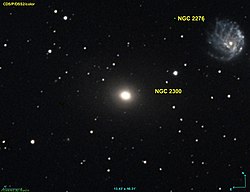|
NGC 2300
NGC 2300 is a lenticular galaxy in the constellation Cepheus.[2] Its velocity with respect to the cosmic microwave background is 1876 ± 7 km/s, which corresponds to a Hubble distance of 90.2 ± 6.3 Mly (27.67 ± 1.94 Mpc).[2] However, 11 non redshift measurements give a distance of 131.98 ± 21.75 Mly (40.464 ± 6.668 Mpc).[5] The galaxy was discovered in 1871 by French astronomer Alphonse Borrelly using an 18 cm telescope.[4] Together with NGC 2276, they form the 114th object in Halton Arp's Atlas of Peculiar Galaxies.[6] According to the SIMBAD database, NGC 2300 is an Active Galaxy Nucleus Candidate, i.e. it has a compact region at the center of a galaxy that emits a significant amount of energy across the electromagnetic spectrum, with characteristics indicating that this luminosity is not produced by the stars.[1] One supernova has been observed in NGC 2300: SN 2024uai (type Ia-91bg-like, mag. 16.58).[7] See alsoReferences
External links
|
||||||||||||||||||||||||||||||||
